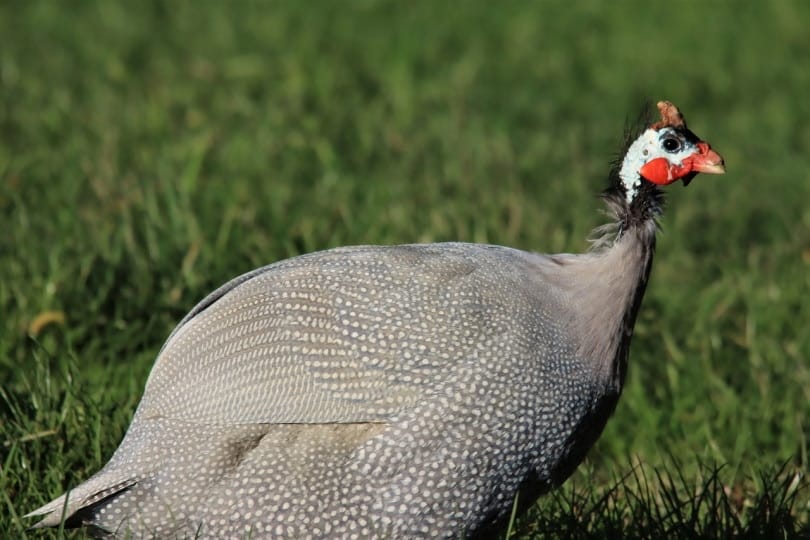If you are like us, you are familiar with chickens and ducks. You may have even raised them on your property. However, you may be less familiar with another great family of birds that are growing in popularity worldwide: the guinea fowl.

What Are Guinea Fowl?
Guinea fowl, also presented as one word, guineafowl, are of birds native to Africa. They are characterized by their featherless heads and boisterous nature.
Guinea fowl are said to resemble partridges and chickens, although they behave differently. While chickens and other common domestic fowl live quite happily on the ground, some guinea fowl prefer high perches. They are also not as tame as chickens and don’t like to be handled.
Guinea fowl are large, with the females usually slightly heavier than the males, weighing up to four pounds. They live in groups, often large flocks, and most mate for life. While these characteristics are true of all guinea fowl, the habitat in which they live varies. Some live in forests while others are found in grasslands. Below we’ll cover the six species of guinea fowl, including the one species most commonly found worldwide.
 The Top 6 Types of Guinea Fowl
The Top 6 Types of Guinea Fowl
There are four genera of guinea fowl. Within each genus, there are one or two distinct species. The characteristics and habitat of each species differ widely which makes these birds fascinating to learn about.
1. White-breasted Guinea Fowl

| Genus: | Agelastes |
| Appearance: | 17 inches high; mostly black with white lower neck, red head |
| Behavior: | Lives in groups of 15–24 birds; nomadic when looking for food |
| Habitat: | Subtropical West African forests |
The white-breasted guinea fowl are found in the forests of Guinea, Ghana, Côte d’Ivoire, Liberia, and Sierra Leone. Their diet is varied; they will happily consume berries, insects, seeds, and even small animals. The white-breasted guinea fowl has a distinctive call that resembles the call of a dove. Unfortunately, these beautiful birds are considered vulnerable and may face extinction in the wild. Many of their habitat forests have been destroyed.
2. Black Guinea Fowl
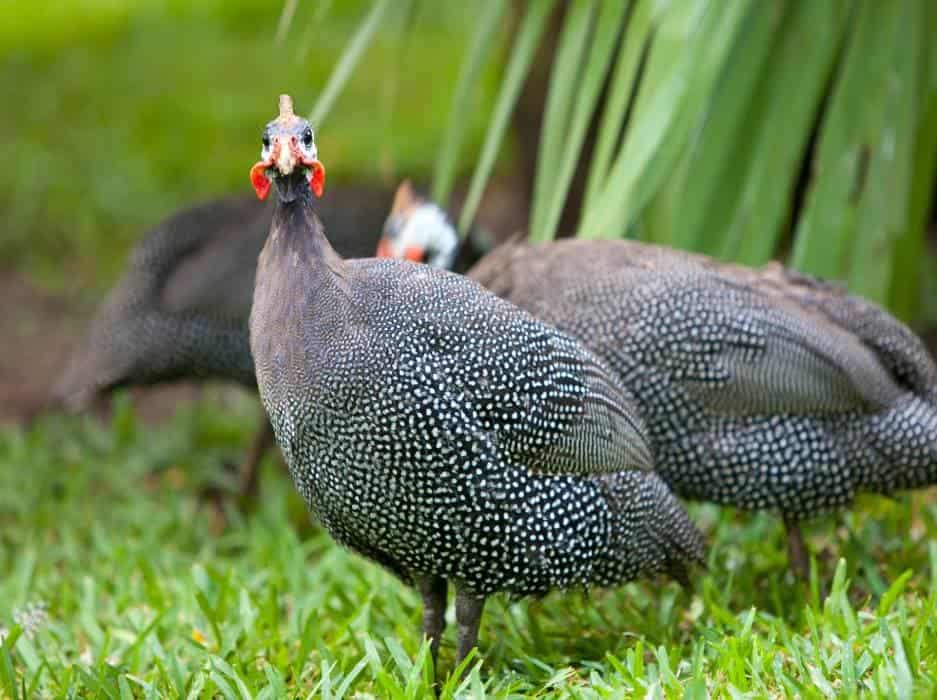
| Genus: | Agelastes |
| Appearance: | 17 inches high; all black with no white; red head |
| Behavior: | Shyer than other species; lives in pairs or small groups |
| Habitat: | Secondary tropical rainforest; West Central Africa |
The black guinea fowl are found in several countries in West Central Africa including Equatorial Guinea, Angola, the Republic of the Congo, Gabon, the Democratic Republic of the Congo, Nigeria, and Cameroon. They like to hide and prefer the thick forest floor where they are hard to spot. The black guinea fowl enjoys eating a variety of insects, berries, small frogs, seeds, and other forest vegetation. Unlike their white-breasted cousins, the black guinea fowl is not believed to be endangered.
3. Helmeted Guinea Fowl
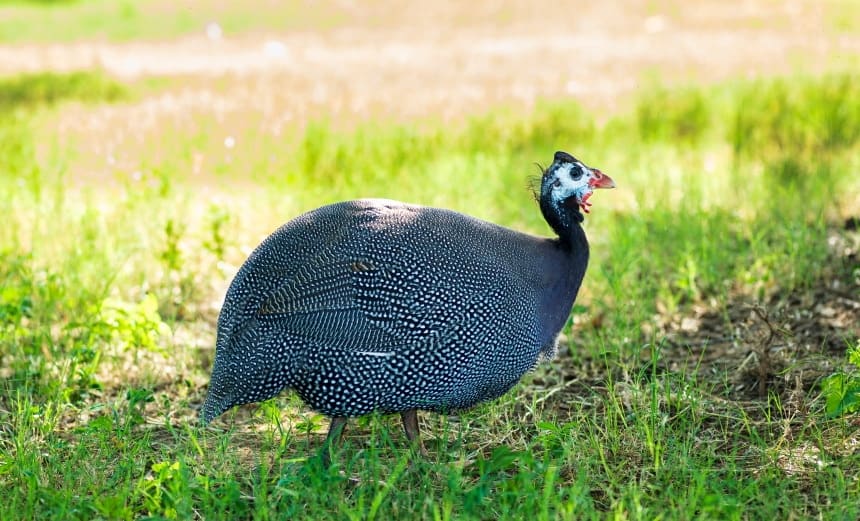
| Genus: | Numida |
| Appearance: | 21 to 23 inches high; grey, black, and white speckled plumage; unfeathered head but does have a reddish or yellow bony knob on the head |
| Behavior: | Lives in large groups of up to 25 birds; forms breeding pairs |
| Habitat: | Throughout Africa in the wild; dry, open land |
The helmeted guinea fowl is the one species that has been widely domesticated. They are found throughout the world on farmland and are mainly used for meat or eggs. They can fly in short bursts, but prefer to walk or run. They have a varied diet consisting of rodents, small reptiles, seeds, roots, potatoes, and other tubers, fruits, and insects. The helmeted guinea fowl is known for its ability to eat massive quantities of ticks, making it useful in areas where ticks are a problem.
4. Plumed Guinea Fowl
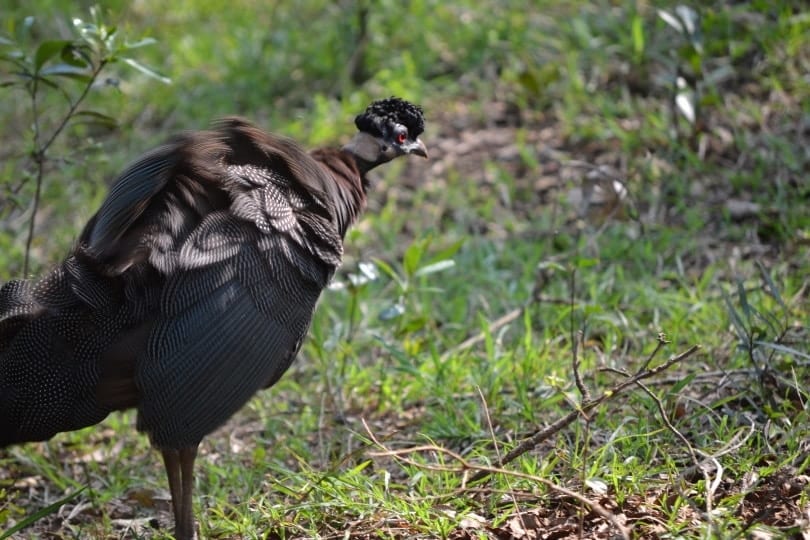
| Genus: | Guttera |
| Appearance: | 17 inches high; black with white spots; large plume of straight black feathers on top of the head |
| Behavior: | Shy, prefers to remain hidden on the forest floor |
| Habitat: | Humid forests in Central Africa; can overlap territory with the black guinea fowl |
Due to their shy nature, less is known about the behavior of the plumed guinea fowl. They live in similar habitats to the black guinea fowl. The plumed guinea fowl eats a variety of insects and forest vegetation.
5. Crested Guinea Fowl
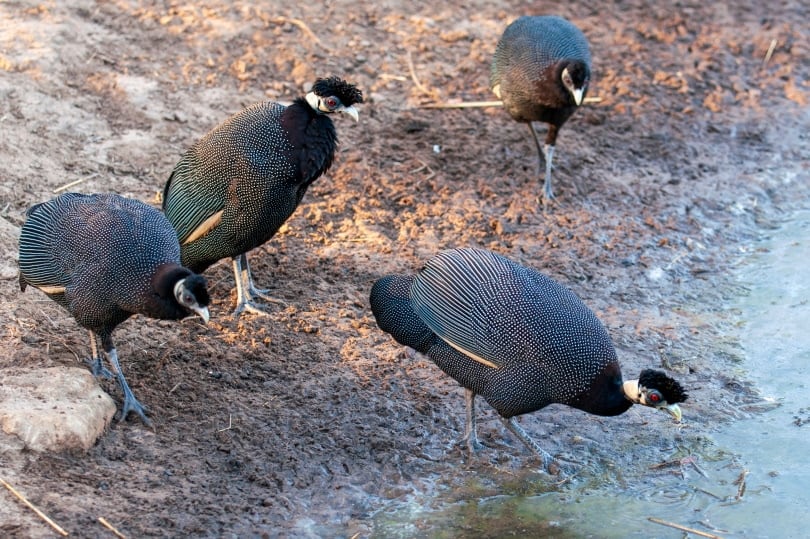
| Genus: | Guttera |
| Appearance: | 18 to 20 inches high; black with white spots; curly black feather crest on top of the head |
| Behavior: | Live in flocks; travel together for safety |
| Habitat: | Eastern African forests and grassland |
The crested guinea fowl is differentiated from the plumed by the fancy, curly crest on top of its head. The crested are also far more gregarious and inquisitive, thus making their sightings more common. They are also often seen in zoos and are a big hit due to their appearance. In the wild, the crested guinea fowl lives in both forest and grassland. They eat leaves, roots, seeds, fruits, and insects.
6. Vulturine Guinea Fowl

| Genus: | Acryllium |
| Appearance: | 24 to 28 inches high; bright blue body with black and white feathers; blue face with a black neck; a cluster of tiny brown feathers on the back of their neck |
| Behavior: | Outgoing, forming groups of up to 50 birds for the mating season; roosts in trees |
| Habitat: | Central African forests |
The vulturine is the largest species of guinea fowl. They can grow up to 28 inches in height and are easily spotted due to their bright blue bodies and heads. Although they rarely fly, preferring to run away from danger, the vulturine guinea fowl do like to roost in trees at night. Even though they are social and travel in huge groups of up to 50 birds, the vulturine guinea fowl are known to be quite aggressive, particularly males toward other males. They can even fight to the death over food or roosting places. They will eat a variety of foods, including insects, roots, rodents, seeds, fruits, and small reptiles. The vulturine guinea fowl can also survive for a long time without water.

Final Thoughts
Hopefully, this article has piqued your interest in these unique birds. While only one species is widely domesticated and raised on farms worldwide, you can still observe many of the others in zoos. The guinea fowls’ color, unique appearance and varied characteristics make them a fascinating group of birds.
Featured Image Credit: Nel Botha, Pixabay
